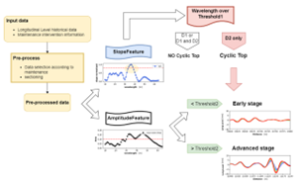
FFG-Success-Story: Improving transportation system detecting Cyclic Top
Track Irregularities at Long Wavelength
Track irregularities cause vehicle dynamic vibrations. To guarantee running behaviour, track loading and ride comfort it is crucial to monitor these irregularities. Usually, studies are focused on vertical irregularities according to the European Standard EN13848 in the wavelength range D1 (3 – 25 m). Long wavelengths (25 – 70 m) have a high potential to be a reason for unexpected vehicle responses, but are often overlooked in the development of new track identification and detection techniques. This research gap has now been closed with the determination of CT defects.
Two Features to Classify CT Defects
The first step of the monitoring involves pre-processing and preparation of the measurement data for analysis. The second stage entails defining two features in accordance with the procedure. Lastly, in the third step, features are analysed by comparing them against predetermined threshold limits in order to detect and classify CT.
The two features defined are named SlopeFeature and AmplitudeFeature. The first one is used to identify evolving periodic defects at long wavelength that can be considered CT. The second feature, named AmplitudeFeature, is used to classify the identified CT defects into different progression phases.

Impact and Effects
Being able to detect track defects in their initial phase, is very important for railway operating companies and infrastructure owners, because it allows them to optimize the maintenance intervention planning and therefore avoid disruption of the transportation service.
In the research project In2Smart2, a method for calculating the SlopeFeature and the AmplitudeFeature has been successfully developed. These values provide insights into track damages in both early and advanced stages.
Project coordination (Story)
Dr. Anna DeRosa
Senior Research
Rail Systems
VIRTUAL VEHICLE Research GmbH
Inffeldgasse 21a
A-8010 Graz
Disclaimer
Virtual Vehicle Research GmbH has received funding within COMET Competence Centers for Excellent Technologies from the Austrian Federal Ministry for Climate Action, the Austrian Federal Ministry for Labour and Economy, the Province of Styria (Dept. 12) and the Styrian Business Promotion Agency (SFG). The Austrian Research Promotion Agency (FFG) has been authorised for the programme management.